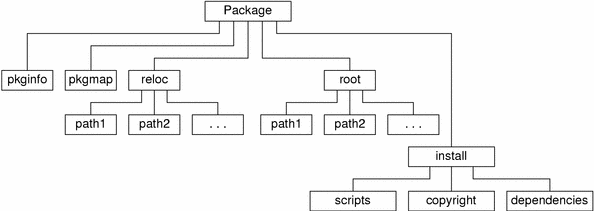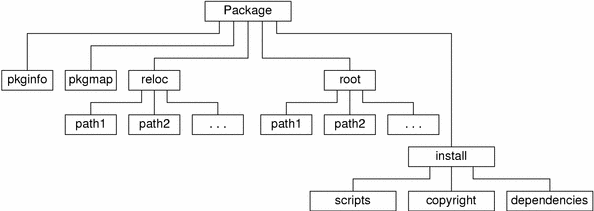The postinstall Script
# postinstall to execute a simple upgrade PATH=/usr/sadm/bin:$PATH UPGR_SCRIPT=/tmp/upgr.$PKGINST if [ -f $UPGR_SCRIPT ]; then sh $UPGR_SCRIPT & fi exit 0 |
Creating Class Archive Packages
A class archive package, which is an enhancement to the Application Binary Interface (ABI), is one in which certain sets of files have been combined into single files, or archives, and optionally compressed or encrypted. Class archive formats increase initial install speed by up to 30% and improves reliability during installation of packages and patches onto potentially active file systems.
The following sections provide information about the archive package directory structure, keywords, clarch utility, and faspac utility.
Archive Package Directory Structure
The package entry shown in the figure below represents the directory containing the package files. This directory must be the same name as the package.
Figure 6-1 Package Directory Structure

The following lists the functions of the files and directories contained within the package directory.
Item | Description |
|---|---|
pkginfo | File describing the package as a whole including special environment variables and installation directives |
pkgmap | File describing each object (file, directory, pipe, etc.) to be installed |
reloc | Optional directory containing the files to be installed relative to the base directory (the relocatable objects) |
root | Optional directory containing the files to be installed relative to the root directory (the root objects) |
install | Optional directory containing scripts and other auxilliary files (except for pkginfo and pkgmap, all ftype i files to here) |
The class archive format allows the package builder to combine files from the reloc and root directoreis into archives which can be compressed, encrypted, or otherwise processed in any desired way in order to increase install speed, reduce package size, or increase package security.
The ABI allows any file within a package to be assiged to a class. All files within a specific class may be installed to the disk using a custom method defined by a class action script. This custom method may make use of programs available on the target system or programs delivered with the package. The resulting format looks much like the standard ABI format. As shown in the following illustration, another directory is added. Any class of files intended for archive is simply combined into a single file and placed into the archive directory. All archived files are removed from the reloc and root directories and an install class action script is placed into the install directory.
Figure 6-2 Archive Package Directory Structure

Keywords
In order to support this new class archive format, three new interfaces in the form of keywords have special meaning within the pkginfo file. These keywords are used to designate classes requiring special treatment. The format of each keyword statement is: keyword=class1[class2 class3 ...]. Each keyword values are defined in the following table.
Keyword | Description |
|---|---|
PKG_SRC_NOVERIFY | This tells pkgadd not to verify the existence and properties of the files in the delivered package's reloc or root directories if they belong to the named class. This is required for all archived classes, because those files are no longer in a reloc or root directory. They are a private format file in the archive directory. |
PKG_DST_QKVERIFY | The files in these classes are verified after installation using a quick algorithm with little to no text output. The quick verify first sets each file's attributes correctly and then checks to see if the operation succeeded. There is then a test of the file size and modification time against the pkgmap. No checksum verification is performed and there is poorer error recovery than that provided by the standard verification mechanism. In the event of a power outage or disk failure during installation, the contents file may be inconsistent with the installed files. This inconsistency can always be resolved with a pkgrm. |
PKG_CAS_PASSRELATIVE | Normally the install class action script receives from stdin a list of source and destination pairs telling it which files to install. The classes assigned to PKG_CAS_PASSRELATIVE do not get the source and destination pairs. Instead they receive a single list, the first entry of which is the location of the source package and the rest of which are the destination paths. This is specifically for the purpose of simplifying extraction from an archive. From the location of the source package, you can find the archive in the archive directory. The destination paths are then passed to the function responsible for extracting the contents of the archive. Each destination path provided is either absolute or relative to the base directory depending on whether the path was located in root or reloc originally. If this option is chosen, it may be difficult to combine both relative and absolute paths into a single class. |
For each archived class a class action script is required. This is a file containing Bourne shell commands which is executed by pkgadd to actually install the files from the archive. If a class action script is found in the install directory of the package, pkgadd turns all responsibility for installation over to that script. The class action script is run with root permissions and can place its files just about anywhere on the target system.
Note - The only keyword that is absolutely necessary in order to implement a class archive package is PKG_SRC_NOVERIFY. The others may be used to increase installation speed or conserve code.
clarch Utility
The clarch utility is used to archive a specific class in an ABI-style package in order to convert it to class archive format. The clarch command calls a custom archive script (archive-script) which is responsible for the creation of the custom archive in the archive directory of the package.
The format for the clarch command is:
clarch [-tuaq] [-d basedir] package archive-script class |
Each option is described in the following table:
Option | Description |
|---|---|
-a | Indicates an absolute archive. The root directory is used instead of the reloc directory. |
-d basedir | Indicates the directory in which the package will be found. |
-u | Indicates that the archive should be undone, which dearchives this class. The contents of the archive are replaced in the reloc directory. |
-q | Indicates a quiet mode. |
-t | Indicates a test mode. |
package | Indicates the name of the package to operate upon. |
class | Indicates the name of the class to archive. |
faspac Utility
The faspac utility converts a standard ABI package into a class archive format used for bundled packages. This utility archives using cpio and compresses using compress. The resulting package has an additional directory in the top directory called archive. In this directory will be all of the archives named by class. The install directory will contain the class action scripts necessary to unpack each archive. Absolute paths are not archived.
The faspac utility has the following format:
faspac [-m Archive Method] -a -s -q [-d Base Directory] / [-x Exclude List] [List of Packages] |
Each faspac command option is described in the following table.
Option | Description |
|---|---|
-m Archive Method
| Indicates a method for archive or compression. bzip2 is the default compression utilities used. To switch to zip or unzip method use -m zip or for cpio or compress use -m cpio. |
-a | Fixes attributes (must be root to do this). |
-s | Indicates standard ABI-type package translation. This option takes a cpio or compresssed packaged and makes it a standard ABI-compliant package format. |
-q | Indicates quiet mode. |
-d Base Directory | Indicates the directory in which all packages present will be acted upon as required by the command line. This is mutually exclusive with the List of Packages entry. |
-x Exclude List | Indicates a comma-separated or quoted, space-separated list of packages to exclude from processing. |
List of Packages | Indicates the list of packages to be processed. |




